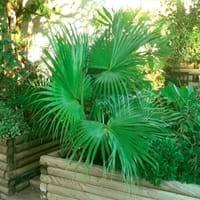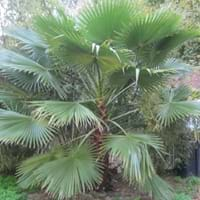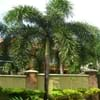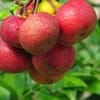Life Span
Perennial
Perennial
Type
Palm or Cycad
Palm or Cycad
Origin
United States, Southeastern United States, South-Central United States
United States, Southeastern United States
Types
Not Available
Not Available
Number of Varieties
Not Available
Habitat
Floodplains, Lowland, River side, Swamps
Coastal sand dunes, Dry areas, moist forests, Wet lands
USDA Hardiness Zone
7-12
8-12
Sunset Zone
H1, H2, 3b, 4, 5, 6, 7, 8, 9, 12, 13, 14, 15, 16, 17, 19, 21, 22, 23, 24
H1, H2, 7, 8, 9, 10, 11, 12, 14, 15, 16, 17, 18, 20, 21, 22, 23, 24
Habit
Clump-Forming
Clump-Forming
Flower Color Modifier
Bicolor
Bicolor
Fruit Color
Chocolate, Black
Black
Leaf Color in Spring
Green, Gray Green, Dark Green
Light Green, Blue Green, Gray Green
Leaf Color in Summer
Gray Green, Dark Green
Green, Blue Green, Gray Green, Silver
Leaf Color in Fall
Green, Gray Green, Dark Green
Blue Green, Gray Green
Leaf Color in Winter
Olive, Gray Green, Dark Green
Blue Green, Olive, Gray Green
Leaf Shape
Circular, dissected, long and linear
Palmate
Plant Season
Spring, Summer, Fall, Winter
Spring, Summer, Fall, Winter
Sunlight
Full Sun, Partial Sun, Partial shade
Full Sun, Partial Sun, Partial shade
Type of Soil
Clay, Loam, Sand
Clay, Loam, Sand
The pH of Soil
Acidic, Neutral, Alkaline
Acidic, Neutral, Alkaline
Soil Drainage
Poorly Drained
Well drained
Bloom Time
Early Summer
Spring, Late Spring
Tolerances
Wet Site, Salt
Wet Site, Pollution, Salt, Soil Compaction
Where to Plant?
Container, Ground
Container, Ground
How to Plant?
Seedlings, Stem Planting
Seedlings
Plant Maintenance
Medium
Medium
Watering Requirements
Do Not over Water, Never Over-water, Requires regular watering, Requires watering in the growing season
Drought Tolerant, occasional watering once established
In Summer
Lots of watering
Lots of watering
In Spring
Moderate
Moderate
In Winter
Average Water
Average Water
Soil pH
Acidic, Neutral, Alkaline
Acidic, Neutral, Alkaline
Soil Type
Clay, Loam, Sand
Clay, Loam, Sand
Soil Drainage Capacity
Poorly Drained
Well drained
Sun Exposure
Full Sun, Partial Sun, Partial shade
Full Sun, Partial Sun, Partial shade
Pruning
Remove damaged leaves, Remove dead leaves
Remove damaged leaves, Remove dead branches, Remove dead leaves
Fertilizers
fertilize every 2-3 weeks while growing
All-Purpose Liquid Fertilizer
Pests and Diseases
Insects
Birds
Plant Tolerance
Drought
Drought
Flowers
Insignificant
Insignificant
Flower Petal Number
Single
Single
Foliage Texture
Bold
Coarse
Foliage Sheen
Matte
Matte
Allergy
Avoid during Pregnancy
gas, Heartburn, Nausea, Stomach pain, Vomiting
Aesthetic Uses
Beautification, Landscape Designing, Showy Purposes
Unknown
Beauty Benefits
Not Available
Not Available
Environmental Uses
Air purification, Food for insects, Prevent Soil Erosion
Air purification
Medicinal Uses
Asthma, Baldness, Cold, Cough, Migraines, Sore throat
chest congestion, Cough, Digestion problems, Inflammation, Sedative, Thyroid problems, Urinary problems
Part of Plant Used
Whole plant
Fruits
Other Uses
Decoration Purposes, Employed in herbal medicine, Showy Purposes, Used as Ornamental plant, Used for its medicinal properties
Paper pulp, Used in herbal medicines
Used As Indoor Plant
Yes
No
Used As Outdoor Plant
Yes
Yes
Garden Design
Bog Garden, Feature Plant, Foundation, Hedges, Mixed Border, Tropical
Container, Feature Plant, Foundation, Mixed Border, Rock Garden / Wall, Tropical
Botanical Name
SABAL minor
SERENOA repens
Common Name
Bush Palmetto, Dwarf Palmetto, Little Blue Stem, Swamp Palmetto
Saw Palmetto
In Hindi
बौना पल्मेट्टो
Serenoa
In German
Zwerg Palmetto
Sägepalme
In French
Palmetto nain
Serenoa repens
In Spanish
Palmetto enano
Serenoa repens
In Greek
Νάνος Palmetto
Serenoa
In Portuguese
Palmetto anão
Serenoa repens
In Polish
Dwarf Palmetto
Serenoa
In Latin
Pumilio Palmetto
Serenoa
Phylum
Magnoliophyta
Magnoliophyta
Class
Liliopsida
Liliopsida
Family
Arecaceae
Arecaceae
Genus
Sabal
Serenoa Hook. f.
Clade
Angiosperms, Commelinids, Monocots
Angiosperms, Commelinids, Monocots
Tribe
Not Available
Trifolieae
Subfamily
Coryphoideae
Coryphoideae
Season and Care of Dwarf Palmetto and Saw Palmetto
Season and care of Dwarf Palmetto and Saw Palmetto is important to know. While considering everything about Dwarf Palmetto and Saw Palmetto Care, growing season is an essential factor. Dwarf Palmetto season is Spring, Summer, Fall and Winter and Saw Palmetto season is Spring, Summer, Fall and Winter. The type of soil for Dwarf Palmetto is Clay, Loam, Sand and for Saw Palmetto is Clay, Loam, Sand while the PH of soil for Dwarf Palmetto is Acidic, Neutral, Alkaline and for Saw Palmetto is Acidic, Neutral, Alkaline.
Dwarf Palmetto and Saw Palmetto Physical Information
Dwarf Palmetto and Saw Palmetto physical information is very important for comparison. Dwarf Palmetto height is 240.00 cm and width 240.00 cm whereas Saw Palmetto height is 210.00 cm and width 300.00 cm. The color specification of Dwarf Palmetto and Saw Palmetto are as follows:
Dwarf Palmetto flower color: Ivory
Dwarf Palmetto leaf color: Green, Gray Green and Dark Green
Saw Palmetto flower color: White
- Saw Palmetto leaf color: Light Green, Blue Green and Gray Green
Care of Dwarf Palmetto and Saw Palmetto
Care of Dwarf Palmetto and Saw Palmetto include pruning, fertilizers, watering etc. Dwarf Palmetto pruning is done Remove damaged leaves and Remove dead leaves and Saw Palmetto pruning is done Remove damaged leaves, Remove dead branches and Remove dead leaves. In summer Dwarf Palmetto needs Lots of watering and in winter, it needs Average Water. Whereas, in summer Saw Palmetto needs Lots of watering and in winter, it needs Average Water.





